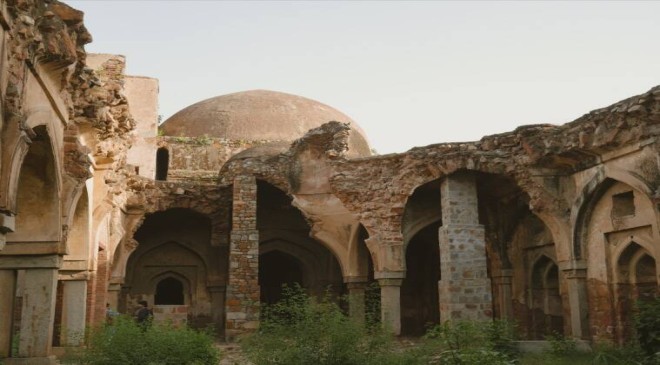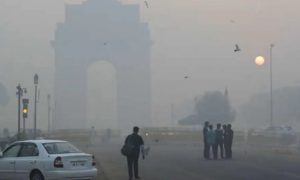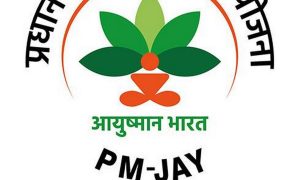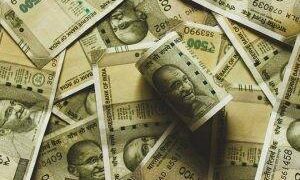Deep in the recesses of Malviya Nagar, where narrow alleys twist and writhe and explode into corridors of drooping electrical wires, butchers and chickens, homes and owners, schoolchildren and parents, cafes and pizzerias, lies a ground of worship.
This is the Begumpur Mosque, but if you ask your way into the cloistered locality looking for it, you will not be directed to it immediately. First you will be pointed towards a smaller property, one sandwiched between private residences and general stores, with faint verses of the namaz wafting out of its green wooden gates.
Then you would have to turn around, walk to a bystander who is already watching you curiously, and clarify: no, you are not looking for the mosque one worships in, you are looking for the mosque one used to worship in.
Sam Dalrymple awaits us at the top of the stone steps leading into the mosque, this one much larger than the other one. He is the co-founder of Project Dastaan, a virtual-reality venture started in 2018 that offers Partition survivors in India and Pakistan glimpses of the homes they abandoned in 1947. He is also working on a book, Five Partitions: The Making of Modern Asia, that seeks to highlight the multiple partitions across South Asia that were a consequence of Britain’s imperial conquest.
Dalrymple believes that Begumpur Village in Malviya Nagar – a village that was inundated with everything from unknown refugees to unknown cuisines as a result of the biggest migration in human history – is an essential enclave of Delhi that has been forgotten within its urbanised folds.
“Imagine you’re standing in old Old Delhi. Before the Mughal Empire, during the Delhi Sultanate’s reign, this was the centre of Delhi,” begins Dalrymple, as we enter the mosque. A vast square courtyard stretches out before us, fenced on all sides by domes dating to the 14th Century. “When Muhammad bin Tughlaq was in power, Begumpur was a part of his capital city, Jahanpanah. And this mosque was the largest one in north India.”
Today, however, the mosque is the second-largest in Delhi (usurped in the 17th century by its more popular brother, the Jama Masjid) and yet “almost nobody knows about it,” says Dalrymple.
He points at the derelict state of the nearly 1,000-sqm courtyard — nobody worships here today. We are surrounded by cracked and crumbling domes. The roof has been cordoned off because someone fell off and died five years ago. According to Dalrymple, there have been attempts to renovate the space by the Archaeological Survey of India (ASI) but none have come through.
“What’s weird, though, is that we don’t even know who built it,” says Dalrymple. “We think it’s Feroz Shah Tughlaq’s prime minister, but even Ibn Battuta — the great Moroccan traveller who has given us some of the best accounts of medieval India — doesn’t mention this mosque at all.”
When Feroz Shah succeeded Tughlaq, Jahanpanah was abandoned in favour of the new capital city, Firozabad. But the residents of Begumpur remained, building a village in what we today know as Malviya Nagar. They built houses — some 97 in number — right inside the mosque, houses that stayed on the spot until it was acquired by the ASI six centuries later in 1927. The residents were given a compensation of Rs 18,179, and the houses within were demolished.
But soon after, something new arrived in their place.
“So many of the narratives of Partition you hear have to do with violence, but the biggest thing you hear out of Begumpur?” says Dalrymple, “The arrival of Punjabi cuisine. Dal makhani was this major invention that no one had ever tried before. You had all these families arriving from Multan, Pakistan, and to this day, there’s a big community of Multani Hindus living here.”
Even up till the 1960s, farms dominated the area, but by the ’80s, student hostels, cafes and “all sorts of bougie places” led to a sudden urban development. However, that history is today colourless, crumbling and craves its former glory. As we leave the compound, Dalrymple elaborates Ibn Battuta’s writings on Begumpur, which are rich with architectural descriptions of wood, paint, tilework and shamianas — none of which survive today.
“A lot of the Mughal era monuments we see are only half the thing because the importance of tents and carpets was huge,” says Dalrymple, hinting at how monuments of the time employed such drapery as walls and doors.
We note a similar absence when we reach the Lal Gumbad complex of Begumpur, the tomb of Sufi saint Sheikh Kabir-ud-din Auliya who died in 1397. Around the tall red sandstone structure, children are flying kites and dogs are roaming on leashes. Scrawny men sit outside the padlocked entrance of the tomb, in sandals, trousers and shirts with rolled-up sleeves, playing cards and smoking.
“Centuries ago, you would have seen a tented passage from here to the mosque,” Dalrymple traces an arc with his finger in the air, “There would’ve been carpets and people selling flowers. Since the ASI took over, you can’t worship here either.”
Ibn Battuta’s writings narrate us to our final destination in Begumpur, one of the oldest palaces in Delhi, the Vijay Mandal — The Hall of a Thousand Columns, as termed by Battuta. “But of course,” says Dalrymple, “there are no columns anymore. They were all wood.” This was once the grand residence of Muhammad bin Tughlaq, now overrun by tall uncut grass, the occasional cigarette butt and not a single chowkidar in sight.
“Begumpur is not well researched. There’s less interest in this period than the Mughal era,” says Dalrymple as we find a small marble shrine of a Sufi saint behind the palace. It lies under a tall peepal tree, with a few extinguished diyas and fresh marigold flowers littered around it.
“I find such shrines very reassuring,” says Dalrymple. “It’s not a massive construction, and just a place where Hindus and Muslims still come to pray. The peepal tree is sacred to Hinduism and has no relevance in Islam, and yet it’s a Sufi saint buried here.”
Dalrymple’s true destination in these grounds, however, is a little higher up. We climb a narrow and steep stone staircase in the palace to emerge on the top and look around: “This is the best view of south Delhi that you can get,” he says, raising his arm to Delhi’s unusually clear skyline that is already sinking its sun under the horizon.
We see everything from the Lal Gumbad and Begumpur’s apartments, to the distant Qutub Minar and Siri Fort complex. Closest to us, however, is a skinny boy leaping from dome to dome of the Begumpur mosque, braving the slippery stone not in pursuit of religion or prayer — but simply of pleasure.





































